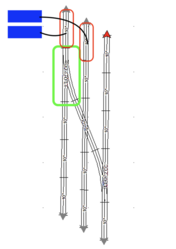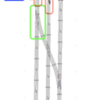I seem to be running in to some issues with one my fastrack switches, and I'm not certain, but I think it may be causing some continuity issues on my layout.
I have two 360 W power masters powering my three loops of track. Each power master is connected to a loop of track, except the inner loop, which is solely receiving power through track continuity across switch tracks and crossovers.
Last night I was having several problems trying to run some trains on all three loops. The Outer loop worked fine with a ES44AC, the middle loop had a weak spot on a corner with a FEF Northern and 4 passenger cars, and the inner loop didn't want to work at all with 2 F-7s (PWR & DMY) and 4 passenger cars.
When me and father quit for the night and were turning things off, my father stumbled across one of my switches that was "hotter than a branding iron" as he put it.
Any guesses on why I seem to be having these issues? I'll attach a mockup of my layout. The green circle highlights the switch in question. The red circles highlight the two terminal tracks I have. The blue bricks are of course the two power masters I have.







